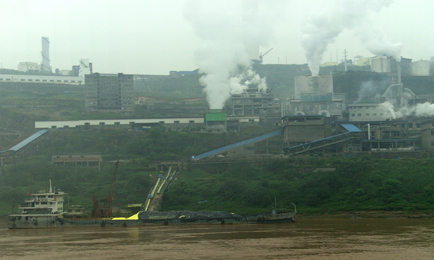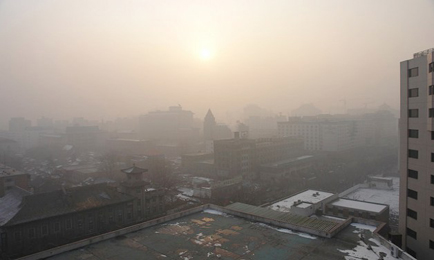Smog city: Pollution in Beijing has risen to unacceptable levels
Big numbers are reported so frequently to describe China that they have become meaningless. For example, China’s economy grows by $1.4 trillion annually. 183,000 engineers graduated in China last year. China used 624 million tonnes of steel last year.
Ironically though, its small numbers that often create the headlines in China - 2.5 for instance.
2.5 microns and under is the size classification used for fine particulate matter (PM) in the air. PM2.5 is a key metric for pollution. PM2.5 particles, which are about 1/30th the width of an average human hair, are believed to be particularly damaging to health because they can penetrate deep into the lungs and become lodged there. Examples of fine particulate matter could be sulfates from power plants and industrial facilities, or nitrates from vehicles.
In January this year, PM2.5 levels in some areas of Beijing were reported to have reached 900 micrograms per cubic metre. The World Health Organisation recommended safe level for PM2.5 is 25. Hospitals reported a 30% increase in patients complaining of breathing problems. Shops sold out of masks and Beijing enacted an emergency response plan for the first time. Visibility dropped to the tens of metres. Think 1950’s London smog.
Some blamed the pollution on people burning more coal because of a harsh winter. But to most the pollution in Beijing is yet another high profile symptom of a country that has experienced massive unchecked industrial growth since the 1980s and is now paying a high environmental price. Further compounding the problem is that China is the second largest energy consumer in the world. Its energy consumption is set to grow at a rate of 4.5% a year for the next 20 years. Over 60% of its power is currently derived from coal.
According to Paul Calver, UKTI specialist in advanced manufacturing, the smog, which afflicts cities throughout the country, has become a turning point for the Chinese people and the government. “People in China have simply had enough of pollution,” he says. There is also an economic cost, he adds. An MIT study published in 2011, found that pollution cost China $112 billion in 2005 through effects such as lost labour and illness.
 Pollution trouble: a view of the Yangtze river in China, which has become a focus point for conservationists
Pollution trouble: a view of the Yangtze river in China, which has become a focus point for conservationists
The Chinese Government has recognised the backlash of opinion and the economic studies. Its response is a typically “massive” national plan that involves plenty of big numbers and ambitious targets. The result is a set of far-reaching energy efficiency and anti-pollution regulations that should affect the environmental performance of all of the industrial sectors of the Chinese economy.
The government aims to reduce energy consumption per unit of GDP by 16% by 2015. It has already introduced a number of laws to clean up energy production. In addition, the State Council is working to expand China’s energy saving industry by 15%, so that by 2015 it will be worth £450bn.It has earmarked some £237 billion to spend on measures to cut pollution and enhance energy efficiency.
“Chinese manufacturers are getting the message to clean up the supply chain. Reducing their energy usage, the amount of raw materials they use, their waste,” says Calver. “There are strong regulations to hit energy efficiency targets and reduce environmental impact. The new government will enforce them with an iron fist, so people are desperate for solutions. “
There are other factors driving a shift to energy efficiency and sustainable manufacturing in China as well as regulatory. Chinese manufacturers need to reduce energy costs to stay internationally competitive because other costs, such as labour and energy, are rising. There is also growing pressure, says Calver, from big customers in the West, who increasingly want evidence that the goods produced in China are being produced in an environmentally sustainable way.
Crucially, says Calver, the Chinese government and industry see energy efficiency and pollution reduction as problems the UK can help to solve, the UK having already travelled, at least some way, down the green sustainability road. According to Calver, the potential value of business opportunities for companies that supply energy efficiency and sustainable manufacturing technology and services in China is more than £10bn. “They need to upgrade plant, train their staff, improve their buildings, procure new energy efficient equipment,” he says.
The biggest opportunities for UK companies is in China's Enterprise Programme being run by the National Development and Reform Council. There are more than 42,000 opportunities in different regions. Five provinces and eight cities are participating in the low carbon programme.
Earlier this year UKTI took a trade mission to China to promote British companies that supply clean energy and sustainable manufacturing equipment. The visit took in three different locations, Jochhin, Wuhan and Chongqing. They were “inundated” with people who wanted to engage with them, says Calver.
“We spoke with a lot of mining, oil and gas and chemicals companies and visited power stations. These people are often relying on one big piece of kit of to make a big difference, so we are targeting factories in sectors like electronics, textiles, automotive, pharmaceuticals and food and drink.”
One of the companies which attended the trade mission is Stoke-on-Trent-based Xtrac, which provides a waste recovery system for viscous slurries. The company’s technology can be used to recover any suspended solids in a liquid waste.
The company’s primary market is sanitaryware factories, where its technology used to reclaim the expensive glaze used on vitreous pottery products such as sinks, toilets and baths. The glaze, which costs around £325 a tonne, is sprayed on in booths which are washed down at the end of a shift. The slurry is collected into a feed tank and Xtrac’s filtration system reclaims the residual glaze and produces clean water. The reclaimed material is identical to the virgin material and can be instantly reused.
The process completely eliminates waste from the glazing process. With an average price of £325 per tonne, a typical sanitaryware factory will use between 3-6 tonnnes of glaze per day. Typical savings on materials are therefore between £300 - 585,000 a year, notwithstanding the environmental benefit, the return of water and the lower challenge to the treatment plant, says Paul Hipkiss, sales and marketing director for Xtrac.
After the production of sanitaryware moved away from the UK, there are now just two plants in the UK, both of which have Xtrac’s filtration equipment installed. Xtrac followed the work overseas. About 90% of the company’s business is now outside of the UK. It has equipment installed as far afield as Mexico, Australia and Russia. Hipkiss says that the UKTI trip to China resulted in a vital first order with a high quality sanitary ware manufacturer, which should be signed off by the end of the summer.
“China is a key market for us. The key is to get the first order – no one wants to be first. Chinese manufacturers want to see it operational. So the order this summer would be a real breakthrough for us,” says Hipkiss. “Our core strategy is to get involved with all the major sanitraryware manufacturers. The trade mission gave us a lot of credibility and support, it’s a helpful platform.”
The first sale opens up a market of at least 15 factories in China. “There’s still a lot of hard work involved, but as long as the Chinese deliver on their promises, and they are paying attention to things like energy efficiency and material utilisation now, they are all applicable” says Hipkiss.

Calver also sees the trip as a success, although he says there was space to take more companies. He says: “One of the major barriers to UK companies taking advantage of the opportunities in China is that a broad number of technologies are involved in making manufacturing more sustainable. There is no single trade association for clean tech.
“The products and services required can range from environmental audits and factory heating to temperature controls. It could include sensing, building insulation, high efficiency electric motors, voltage matching equipment, water filtration.”
“You have state legislation, money and personal incentives. This is a great opportunity for UK companies that can supply this market.”
The distance from Stoke-on-Trent to China may be large, but so is the need for environmental technologies and services in its industry. Small companies with the requisite expertise may find they have a big impact where it is needed most.